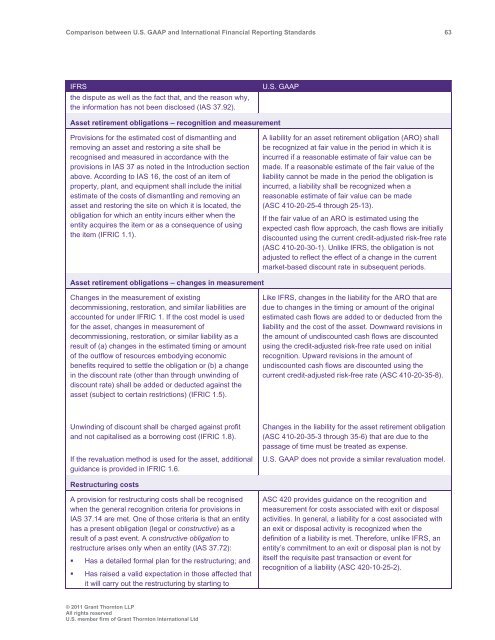Comparison between U.S. GAAP and International ... - Grant Thornton
Comparison between U.S. GAAP and International ... - Grant Thornton
Comparison between U.S. GAAP and International ... - Grant Thornton
Create successful ePaper yourself
Turn your PDF publications into a flip-book with our unique Google optimized e-Paper software.
<strong>Comparison</strong> <strong>between</strong> U.S. <strong>GAAP</strong> <strong>and</strong> <strong>International</strong> Financial Reporting St<strong>and</strong>ards 63<br />
IFRS<br />
the dispute as well as the fact that, <strong>and</strong> the reason why,<br />
the information has not been disclosed (IAS 37.92).<br />
U.S. <strong>GAAP</strong><br />
Asset retirement obligations – recognition <strong>and</strong> measurement<br />
Provisions for the estimated cost of dismantling <strong>and</strong><br />
removing an asset <strong>and</strong> restoring a site shall be<br />
recognised <strong>and</strong> measured in accordance with the<br />
provisions in IAS 37 as noted in the Introduction section<br />
above. According to IAS 16, the cost of an item of<br />
property, plant, <strong>and</strong> equipment shall include the initial<br />
estimate of the costs of dismantling <strong>and</strong> removing an<br />
asset <strong>and</strong> restoring the site on which it is located, the<br />
obligation for which an entity incurs either when the<br />
entity acquires the item or as a consequence of using<br />
the item (IFRIC 1.1).<br />
A liability for an asset retirement obligation (ARO) shall<br />
be recognized at fair value in the period in which it is<br />
incurred if a reasonable estimate of fair value can be<br />
made. If a reasonable estimate of the fair value of the<br />
liability cannot be made in the period the obligation is<br />
incurred, a liability shall be recognized when a<br />
reasonable estimate of fair value can be made<br />
(ASC 410-20-25-4 through 25-13).<br />
If the fair value of an ARO is estimated using the<br />
expected cash flow approach, the cash flows are initially<br />
discounted using the current credit-adjusted risk-free rate<br />
(ASC 410-20-30-1). Unlike IFRS, the obligation is not<br />
adjusted to reflect the effect of a change in the current<br />
market-based discount rate in subsequent periods.<br />
Asset retirement obligations – changes in measurement<br />
Changes in the measurement of existing<br />
decommissioning, restoration, <strong>and</strong> similar liabilities are<br />
accounted for under IFRIC 1. If the cost model is used<br />
for the asset, changes in measurement of<br />
decommissioning, restoration, or similar liability as a<br />
result of (a) changes in the estimated timing or amount<br />
of the outflow of resources embodying economic<br />
benefits required to settle the obligation or (b) a change<br />
in the discount rate (other than through unwinding of<br />
discount rate) shall be added or deducted against the<br />
asset (subject to certain restrictions) (IFRIC 1.5).<br />
Like IFRS, changes in the liability for the ARO that are<br />
due to changes in the timing or amount of the original<br />
estimated cash flows are added to or deducted from the<br />
liability <strong>and</strong> the cost of the asset. Downward revisions in<br />
the amount of undiscounted cash flows are discounted<br />
using the credit-adjusted risk-free rate used on initial<br />
recognition. Upward revisions in the amount of<br />
undiscounted cash flows are discounted using the<br />
current credit-adjusted risk-free rate (ASC 410-20-35-8).<br />
Unwinding of discount shall be charged against profit<br />
<strong>and</strong> not capitalised as a borrowing cost (IFRIC 1.8).<br />
If the revaluation method is used for the asset, additional<br />
guidance is provided in IFRIC 1.6.<br />
Changes in the liability for the asset retirement obligation<br />
(ASC 410-20-35-3 through 35-6) that are due to the<br />
passage of time must be treated as expense.<br />
U.S. <strong>GAAP</strong> does not provide a similar revaluation model.<br />
Restructuring costs<br />
A provision for restructuring costs shall be recognised<br />
when the general recognition criteria for provisions in<br />
IAS 37.14 are met. One of those criteria is that an entity<br />
has a present obligation (legal or constructive) as a<br />
result of a past event. A constructive obligation to<br />
restructure arises only when an entity (IAS 37.72):<br />
• Has a detailed formal plan for the restructuring; <strong>and</strong><br />
• Has raised a valid expectation in those affected that<br />
it will carry out the restructuring by starting to<br />
ASC 420 provides guidance on the recognition <strong>and</strong><br />
measurement for costs associated with exit or disposal<br />
activities. In general, a liability for a cost associated with<br />
an exit or disposal activity is recognized when the<br />
definition of a liability is met. Therefore, unlike IFRS, an<br />
entity’s commitment to an exit or disposal plan is not by<br />
itself the requisite past transaction or event for<br />
recognition of a liability (ASC 420-10-25-2).<br />
© 2011 <strong>Grant</strong> <strong>Thornton</strong> LLP<br />
All rights reserved<br />
U.S. member firm of <strong>Grant</strong> <strong>Thornton</strong> <strong>International</strong> Ltd
















